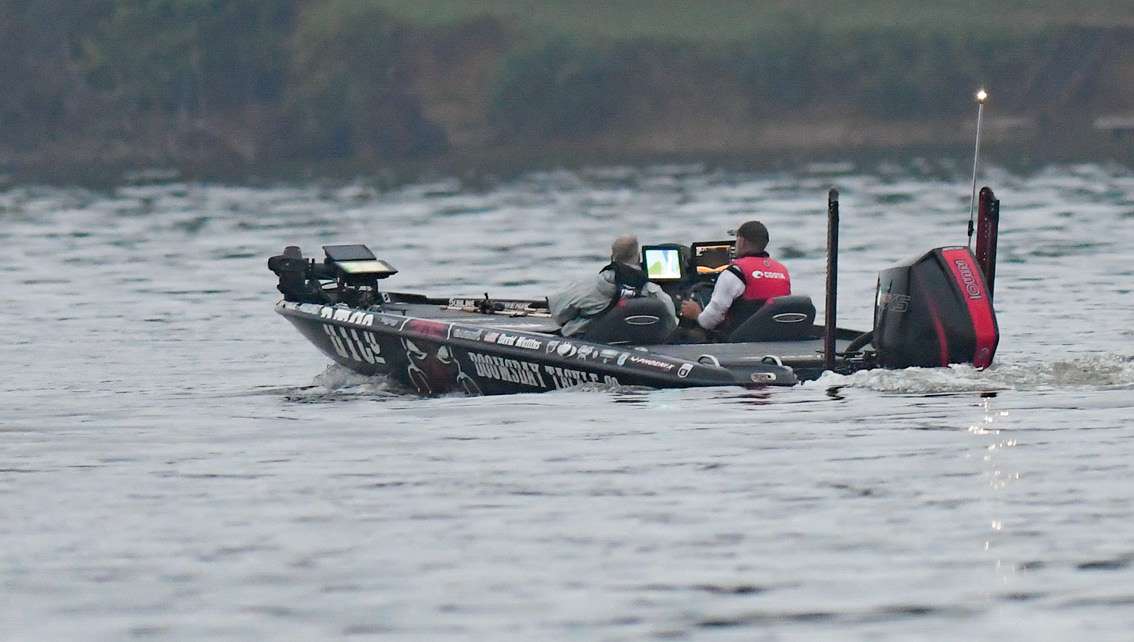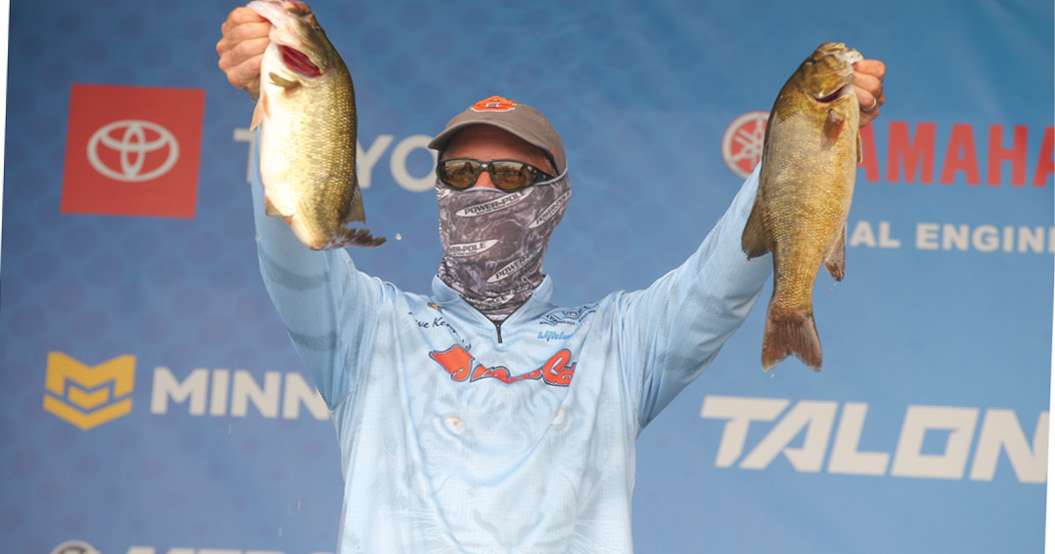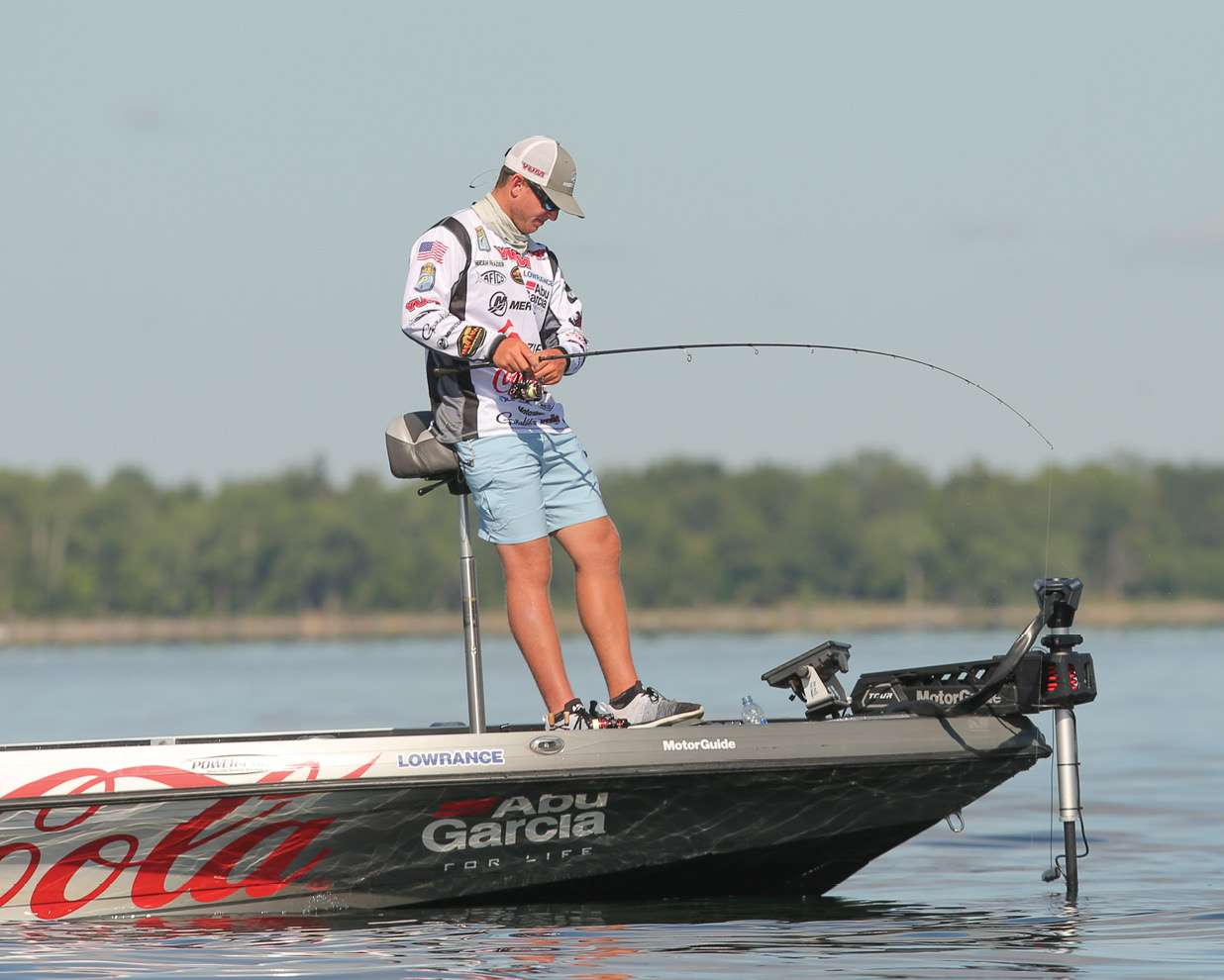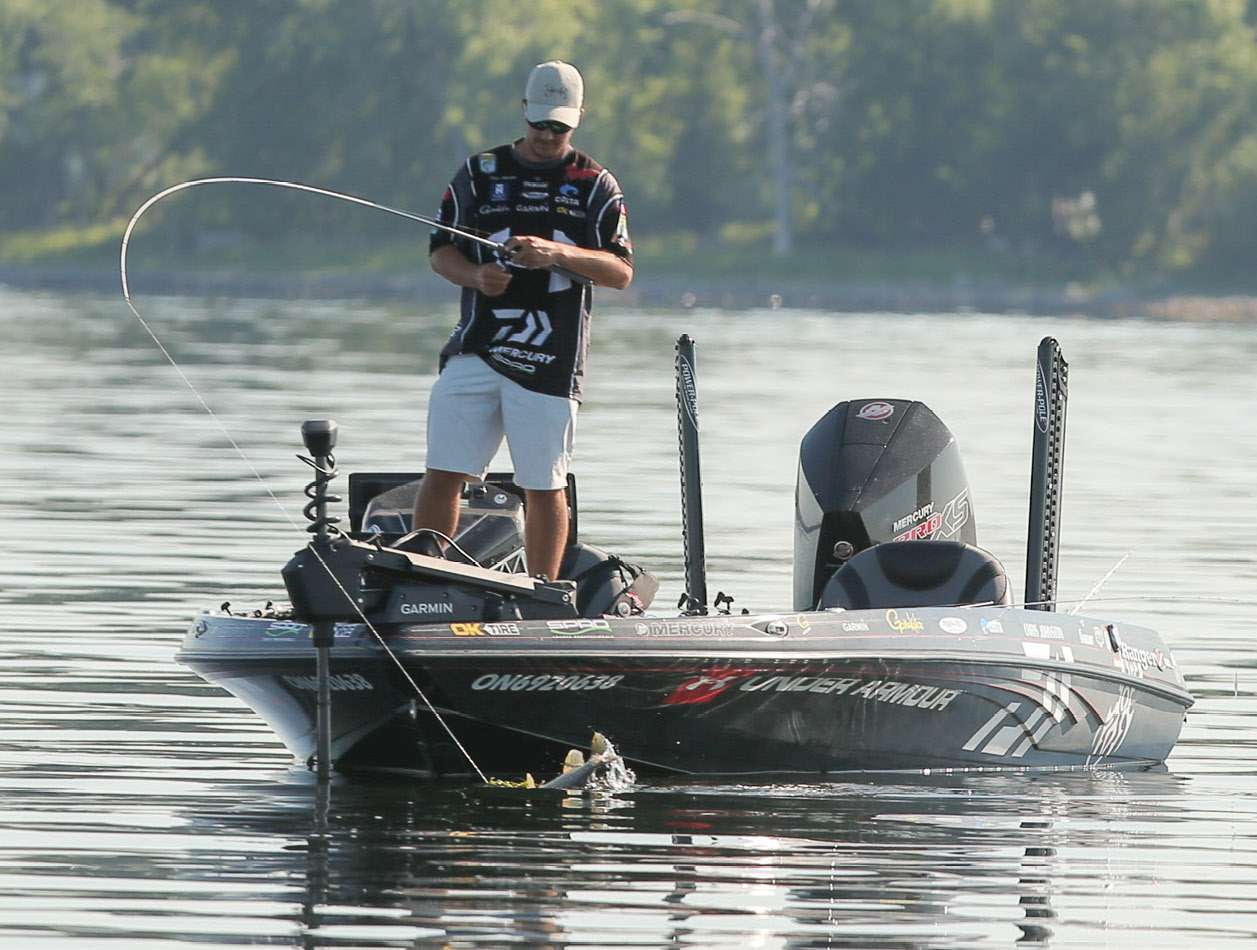
Every Bassmaster Elite Series angler has a painful tale of a near-win, a total bomb or something in between where a key decision shifted the outcome one way or another. Within these tales, we find a rich harvest of techniques, tactics and timing that can help all anglers sharpen their game.

Adjustment delayed
David Mullins
Event: Lake Eufaula (2020)
Scenario: The early June event found fish settled into summer patterns, but water fluctuation disrupted their normal positioning.
The decision: Knowing that this Chattahoochee River reservoir typically sees the offshore structure playing a significant, if not dominant, role in summer events, Mullins devoted his entire practice to graphing the deep spots. Looking for schools on channel swings and other sweet spots seemed like the right call, but his crankbait and swimbait efforts yielded little.
“When I go to these structure lakes I’m really keyed in on [offshore] structure, and I really want to catch them that way,” Mullins said. “Sometimes, I put too much emphasis on idling too long when they’re not there and trying to find the one deal out there.”
When he realized his offshore strategy wasn’t going to pan out, Mullins moved up shallow and used a big Texas-rigged worm to target brush in 6 to 10 feet. Placing 46th, Mullins caught a limit of 13-14 on Day 1. On Day 2, the worm produced a better limit, 16-14, but it was too late to make up lost ground.
Game Changer: With rising water bringing a lot more of the lake’s shallow cover into play, the offshore game lost its luster. Fish were leaving the deep spots daily, and the recently predictable schools broke up, with fish scattering throughout the nearshore brushpiles.
“There had been a lot of rain, and the lake was steadily coming up — that puts them on the bank,” Mullins said. “Even though it’s a legendary ledge lake, it just wasn’t going on.”
Takeaway: Historical references are only as good as their present-day application. That’s the point Mullins said he had to embrace. Had current conditions matched the tried and true, he would have been well-prepared. This time around, he knows that his devotion to a preferred pattern ended up biting him.
“I like fishing that offshore structure so much, I’ll get carried away and keep reaching for schools when they’re really not out there,” he said. “Sometimes it pays off big, but sometimes I get carried away and it doesn’t work.”
In this instance, he got sucked into a time-devouring search in the wrong scenario. Mullins knew the options, but Eufaula’s 102,000 acres presented a lot of water to break down.
“Sometimes, you have to go fishing, instead of relying on where they should be,” he said. “This lake is so big and you don’t have time to cover it all. When you spend so much time looking offshore, you don’t have time to fish brush; you can’t hardly do both.”

Wind was not a friend
Steve Kennedy
Event: Lake Champlain (2020)
Scenario: Champlain kicked out plenty of quality fish, but little to no current in the early goings presented challenging conditions for much of the field.
The decision: Kennedy spent his first morning hunting smallmouth in the Rouses Point area with a swimbait before throwing a jig for afternoon largemouth in the Inland Sea. Buoyed by two good largemouth bites, the plan put him in 49th place with a limit of 16-8, but a slower Day 2 yielded only 15-3 and dropped him to 62nd.
Unhappy with his morning smallmouth bite, Kennedy reversed his Day 2 plan and caught a limit of largemouth before returning to Rouses Point and burning the rest of his day without a smallmouth bite. Lamenting the still water, Kennedy said his second morning was nothing like the afternoon of Day 1.
“I went looking for those largemouth where I’d had seven bites the day before,” he said. “There was absolutely zero current moving out of that lake, and those fish weren’t there. I figured it out within an hour or two.”
Game Changer: Practice on Champlain saw a lot of wind-driven current, which tends to position smallmouth and stimulate aggressive feeding. Smallies are sight feeders that appreciate clear visibility, but still water can make them edgy. Wind rings the dinner bell by disorienting baitfish.
With the exception of a Day 1 storm, the first two days saw mostly calm conditions. Day 4 brought big southern winds, but Kennedy didn’t make the Day 3 cut, so he missed the opportunity.
Kennedy’s Day 2 bag included a squeaker that went 12 1/4 inches. Replacing that with another solid largemouth or a kicker smallie likely would’ve advanced him to Day 3 and offered a shot at adjusting enough for a run at the Top 10.
Takeaway: Fishing conditions very different from what he faced in practice, Kennedy said he should have recognized that there was not enough wind and, therefore, insufficient current to make smallies chase his swimbait. Clear, calm conditions usually require anglers to cover a lot of water, and he believes he would’ve fared better by throwing a smaller bait with a faster pace.
“Knowing what I know now, I would have adjusted quicker to the lack of current,” Kennedy said. “I adjusted, but I didn’t give myself enough time.
“I’m prone to throwing a big swimbait, so you don’t expect to get but one bite an hour, so it takes an hour or two to realize something’s wrong. You keep thinking you’re going to put it in front of the right fish.”
Also, he got clued in to the Carolina rig, which fellow Elite Series pro Jamie Hartman and others used, too late.
“Jamie fished near me both days, and I kept hearing that Carolina rig going KAPLOOSH and I thought, ‘Good Lord, what is he throwing?’” Kennedy said. “On Day 2, I watched him catch three or four, and any one of those would have bumped me up at least 1 1/2 to 2 pounds.”

Know when to switch
Micah Frazier
Event: Lake Champlain (2020)
Scenario: Late July on the stunning lake straddling the New York-Vermont border saw a big smallmouth showing with quality largemouth making isolated appearances.
The decision: With a 13th-place finish, Frazier certainly made a respectable showing, but the Georgia angler left Champlain with a gnawing feeling that he’d missed an opportunity for an even better performance. That thought, he said, stemmed from what he saw as a weak link in an otherwise sensible game plan.
Spending his tournament within the Inland Sea (Champlain’s northeast branch, on the Vermont side), Frazier fished in the 25- to 30-foot range and caught good smallmouth with little difficulty on a drop shot with a Yum Warning Shot. After that, he moved shallow and flipped milfoil patches with a 5/8-ounce jig with a Yum Spine Craw.
“At Champlain, you want to find a good limit, a good 17- to 18-pound limit, of smallies in the morning and then go cull with one or two big largemouth,” Frazier said. “I found the quick limit of smallies and I was able to do that, but on Days 2 and 3, I dropped the ball; I really struggled to go and cull and upgrade from 17 pounds to 20.”
Frazier’s confident that he was in the right part of the lake for quality of both species, but he realized his practice effort was more focused on finding deep smallmouth spots than the shallow cover where Champlain’s biggest green fish live. This overweighted emphasis got him going in the right direction but left him unable to close the deal.
Game Changer: Champlain’s record low water level was about 92.4 feet in 1908 and, while the lake was nowhere near that mark, it was at least a foot below the 96.5 average — and about 3 1/2 feet down from spring levels. Unlike a TVA lake, where some degree of predictable fluctuation exists, Champlain can be less accommodating.
“It’s a glacier lake and there’s a dam, so you get what you get,” Frazier said. “It changes from year to year, depending on rain.
“That low water level took a lot of the largemouth cover out of play. Normally, you’d fish bank grass, reeds, flipping shallow cover, flooded trees and boat docks. It opened up a lot of stuff I’d never fished before.”
Frazier didn’t view this as a worse situation — just different. In his view, a normal or higher water level would have offered greater shallow opportunities with more big largemouth crossing the weigh-in stage.
One key metric, Ticonderoga, was oddly silent. Normally, this shallow, grassy area at Champlain’s lower end cranks out competitive largemouth limits, but its complete lack of productivity bespoke the low-water blues.
“If the water had been higher, I think you might have seen people devoting their whole event to fishing for largemouth,” Frazier said.
Takeaway: With the exception of a more typical Ticonderoga deal, Frazier said that Champlain consistency requires a mixed bag. He had the smallmouth program locked down but noted that it’s often hard to get past the 17- to 18-pound mark unless you spend all day culling.
“The most consistent way to catch 20 pounds or more on Champlain is with three smallies and two big largemouth,” Frazier said. “It’s a whole lot easier to catch a 5-pound largemouth than it is to catch a 5-pound smallmouth.
“I stayed out deeper and tried to cull through smallmouth all day, and it just never happened. On Day 1, I caught 20 pounds of smallmouth, but on the second and third days, when I wasn’t getting those 4-pound bites as often, I should have known I should go do something different. I think that would have been the difference maker in making the Top 10 cut.”
In retrospect, Frazier knows he should have spent more of his practice identifying areas where he could depend on a big flipping bite. That would have given him a reason to leave the smallmouth game at a reasonable point.
“If I could do that one over, I would love the opportunity to spend a little more of my practice time looking for that isolated largemouth cover where I could go catch a 5-pounder or a couple of 4 1/2-pounders and set myself apart,” Frazier said. “I needed to find those small patches of milfoil or boat docks or any shallow, hard structure.”

Needed a fallback plan
Chris Johnston
Event: St. Johns River (2020)
Scenario: The February event on Florida’s famed tidal river saw a mostly prespawn scenario with early spawn elements.
The decision: With limited experience on the St. Johns, Johnston drew upon his previous visit in 2019 and spent his practice searching for beds in the Lake George area. Given the full moon arriving during the tournament, that normally would have been a solid call.
“It had been tough to get a bite from prespawn fish, so I got it stuck in my head that I was going to go try and find some bed fish since the water was warming up,” Johnston said. “I found a few on beds, but the lake went down about a foot and a half. My beds were [initially] in about a foot and a half to 2 feet, so they were basically dry during the tournament.”
Johnston admits this drastic change threw him a curveball because he was banking on a Top 30 finish with the quality and quantity of beds he’d found. Once he realized that deal was out, he junk fished his way through Day 1 and scratched up three keepers.
On Day 2, Johnston spent his morning flipping deeper pads in hopes of finding relocated bed fish. By midday, he had transitioned to canals off Lake George and some closer to the takeoff in downtown Palatka, where he was blind casting a wacky-rigged 5-inch Senko for unseen beds. Johnston got several good bites but only caught two keepers.
“I lost three good ones on Day 2 and should have had a pretty good weight,” Johnston said. “I just wish I’d had more time to do this in the afternoon.”
Game Changer: A fierce storm passing through the Southeast brought big winds that canceled the event’s first two days and ultimately extended it to a Championship Monday conclusion. During the postponement, Thursday and Friday saw steady whitecaps and pounding waves that stirred the river and its major pools — Lake George and Crescent Lake.
The wind not only muddied the exposed waters, it blew the outgoing tides about a foot lower than normal. The wind decreased to a safe level by Saturday, but it continued to blow and actually held back the incoming tide for most of the tournament. (Notably, winter tides are typically the year’s lowest, while a full moon’s maximum pull means even lower levels.)
Takeaway: Johnston’s key lesson: “I should not have gotten stuck on the bed fish I could see. There are fish in those canals that bed in deeper water. You have to have patience and [imagine] there’s a bedding fish on each cast and fish it slowly.
“If I would have done that for two days of the tournament, I know I would have done well. Looking back, probably half of the Top 10 were doing [something similar]. I was just a little slow getting on that program because I hadn’t done it in practice. I figured out that slowing down and blind fishing was the deal, but I just ran out of time.”
Johnston tried making a sensible Day 1 adjustment by looking for prespawners that hadn’t pulled up, along with any bed fish that had dropped out with the falling water. Ultimately, he realizes that pressing the reset button and shifting to a completely different technique in scenarios where the low water would have less impact would have been a better use of his time.
Originally appeared in Bassmaster Magazine 2020.

